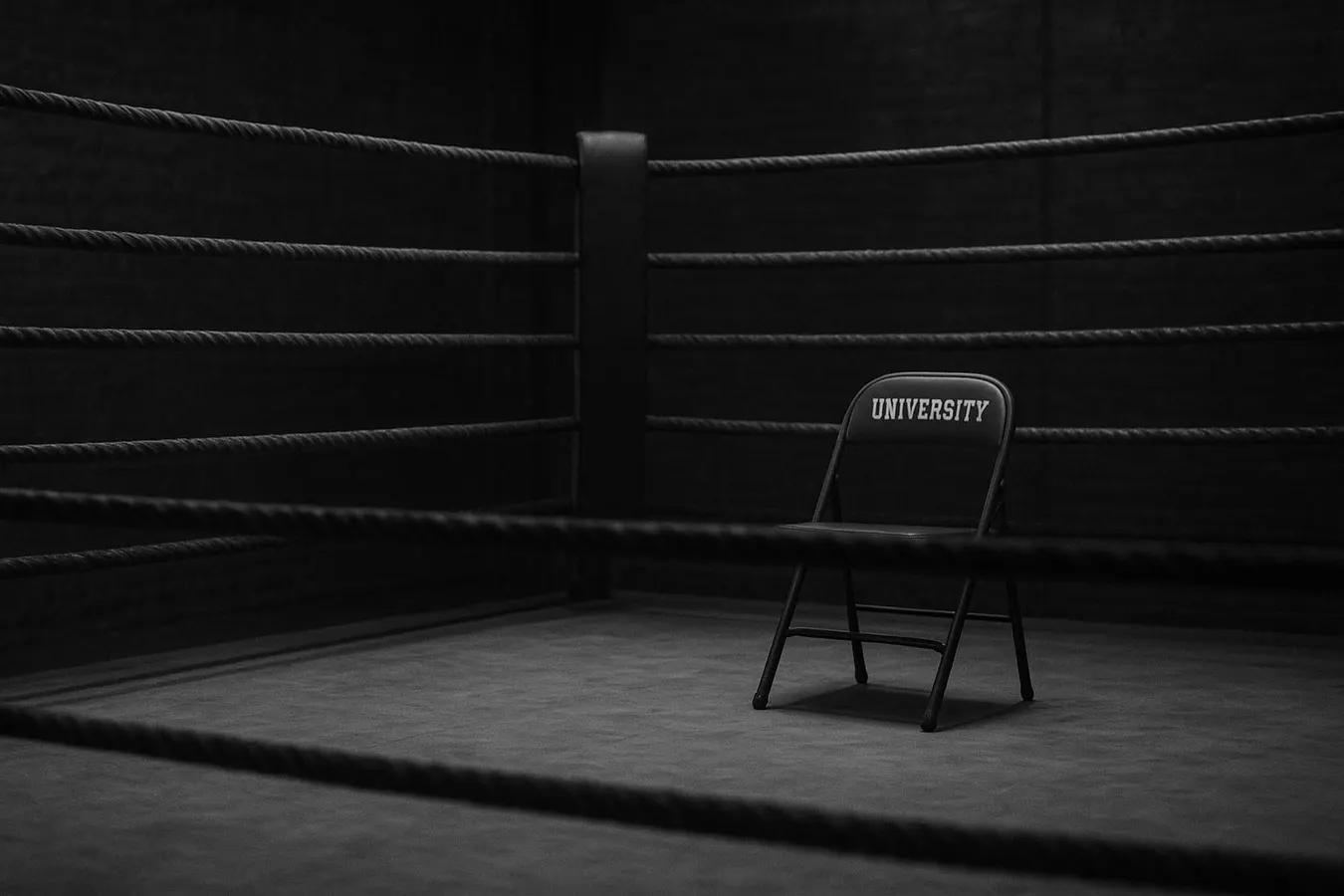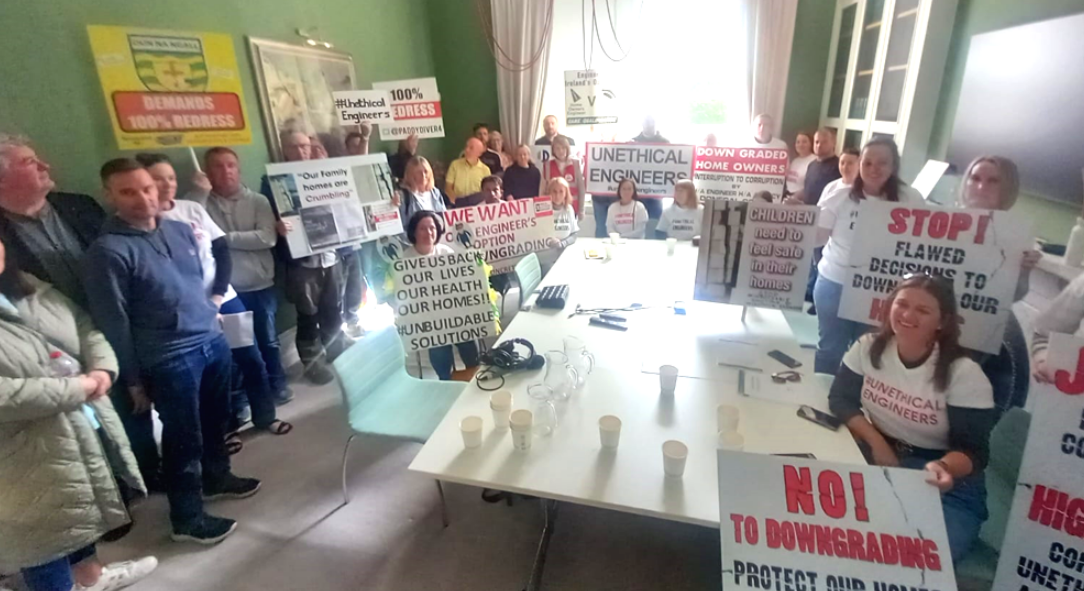By Contributor,David Rosowsky
Copyright forbes

How did higher ed end up in the ring, with its own chair nonetheless? Step right up and take a swing. Everyone else is.
Stock image
Higher education in the U.S. is being challenged, roiled, and shaken to its core. It has become the perfect foil for all sides, all parties, all sectors, and all comers. Step right up and take a swing. Everyone else is.
How is it that has higher ed become the great unifier in a divided nation, the favored scapegoat, the target of collective anger, and blamed for all that now ails us as a nation and a society? It’s absurd to think our colleges and universities can be to blame for all of it. But it’s arrogant to think they have played no part in justifying the criticism and earning the backlash.
I have written on this topic (the why and the how) elsewhere. I also have written about why higher education has been slow to recognize, let alone respond, instead favoring reaction (disbelief) and resistance (defiance). But I would argue that we have moved into a new phase now. Like it or not, the reshaping of higher ed is now underway, the result of a series of federal (and in some cases, state) actions, and there is a collective acknowledgment that change is happening – and will happen – whether those on the inside participate or not. This, I refer to as, the great resignation. Not a resignation of position or employment, but to inevitable change.
I see this as a positive step, indeed a positive time, for anyone truly committed to securing higher ed’s future. Energy can now be directed to shaping our collective future.
To be clear, I am not arguing against pouring energy into protecting what we value. Neither am I failing to acknowledge the important role our institutions have played in resisting challenges to their autonomy, driving social reform, and fighting for equitable access to higher education and the many opportunities such access affords. Rather, I am suggesting we now have a new opportunity to create a newdynamic.
We can pour all our collective energy into shaping higher ed’s future from the inside out and leveraging new types of partnerships. We can do all of this in such a way as to engender trust, confidence, and support from those who would criticize us today. We can restore higher ed’s central role in driving our economy, creating prosperity, lifting individuals and communities, serving our national interests, and maintaining our global leadership. We can make a new and needed case for pursuing a higher education. We can return to the days when ROI was never in question, it was about creating opportunity for a better life for each subsequent generation. Finally, we can put our institutions on a solid and sustainable footing financially. By taking responsibility for making the needed (some would argue long needed) changes now, we can break free from the decades-long pattern of budget cuts, trimming around the edges, and hollowing out of our institutions to the point of both operational and morale instability. We can design, evolve, and operate our institutions as strategic, focused, optimized, and efficient enterprises. We can commit to being the best at becoming better, models of organizational adaption and evolution, to balancing the needs of our nation, society, and students with our institutional values. This balance has proven very difficult to achieve for most institutions.
MORE FOR YOU
So, what comes next? Where might today’s challenges and the imperative for change take us? What are the most pressing needs and the most promising opportunities? Here, I offer observations/thoughts in four areas: enrollment trends, federal support for research, D1 athletics, and governance. By no means a complete list, these are among the most pressing issues for higher ed leaders and boards today, especially those at large public research institutions (flagship and land-grant universities).
Revenue, Enrollments
Despite the headlines, enrollments are UP at many universities this fall, with many reporting new record undergraduate enrollments. What we are seeing is more than just a demographic cliff. We are seeing a demographic shift as well. Students are choosing large public universities (especially flagships and land-grants) at record numbers. They see greater value, more options, and more opportunities at these large public research universities. Location, D1 athletics, vibrant campuses, and huge alumni bases (and potential employment connections) also may figure into their decision. But the demographics (numbers of high school graduates and college-bound students) are real. Thus, these reported enrollment increases can only be happening at the expense of enrollments at other institutions. And therein lies the real headline.
With the threat of decreased research funding, rising costs of fielding competitive athletics teams (to say nothing of NIL), and escalating utility costs and deferred maintenance obligations, universities understandably are seeking to increase their tuition revenue. And those that can, are doing so. They are running the numbers, entering into new public-private partnerships to rapidly build new student housing, investing in new teaching and research facilities, and turning the spigot to welcome larger numbers of students from their deepening applicant pools. Those that can.
The federal government has taken steps to significantly alter, and in some cases severely curtail, the research funding available to university researchers. In addition to proposed reductions and eliminations of entire areas of federally funded scientific research, there are proposals to significantly reduce the indirectcosts paid on grants, funding that is essential for universities to be able to conduct and support the research. There have been new restrictions placed on international students seeking visasto study and work in the United States. Recent weeks have seen calls for taxing university-generated IP revenue. Proposals and executive orders to gut or dramatically reshape university-based research keep coming. Some will be blocked by Congress or deemed illegal by the courts, others will be implemented. It’s all quite murky so, for now, we wait.
All of this uncertainty has caused predictable responses by universities. Pausesin faculty hiring and even capital construction, freezes on PhD student admission, closure of labs, and termination of research activity in areas that no longer align with federal priorities. Only a small number of universities have been able to provide bridge funding to researchers and graduate students during this period of chaos and uncertainty. Many have written about the short and long-term consequences of such an abrupt change in federal support for research. And while we wait for tactics and directives to become clear, and for the courts to weigh in some cases, the damage is mounting. The tech sector, which has been critically dependent on university research and discovery for decades, has been largely silent, despite the fact that they are likely to face some of the greatest consequences of a diminished U.S. scientific research enterprise.
The future, whether in one of diminished federal support or just continued uncertainty in the availability of future funding for university-based research, will be one of new and more diverse sources of funding. Entrepreneurial faculty will build new partnerships with industry, seek philanthropic support for their research, or perhaps even start their own companies and pursue private capital.
Universities will tighten their research operations to focus their resources on a smaller number of areas. Academic medicine is likely to be hit very hard at all but the largest and most well-funded academic medical centers. Universities will need to make hard decisions to close the gap left by the expected reduction in indirect costs, if they choose to continue to support research in those areas.
It would be reasonable to expect a tightening (focusing) of research activity and a commensurate reduction in investments by universities in facilities and personnel. Universities will become more specialized in the types of research being conducted. Such a rebalancing of capacity and capital may, in fact, be sensible if it leads to greater efficiency in the R&D process. But deep and across the board cuts to federal funding for research, coupled with other taxes being proposed on institutions and investigators, is not the best way to achieve such an outcome. The goals and the strategy being employed by the federal government are both very unclear at the present time.
NCAA Division 1 Athletics
Where to begin? What started as a sincere attempt to do the right thing by our great student-athletes, recognizing and sharing in the significant revenue their efforts bring to their university, has turned monstrously ugly. The system (if it can be called such) is unwieldy, untenable, unsustainable and, in the light of day, indefensible.
Without rules, regulations, or guardrails – which seem not to have been contemplated at its origin – NIL will continue to challenge institutions, coaches, teams, and fan bases. The sum of moneybeing paid to athletes is staggering at some schools. I find the term “collective” to describe the NIL funding mechanism curious. I suppose students and parents paying tuition are another collective (NTR, net tuition revenue), and alumni donors another (NDS, national donor support).
As hideous as the NIL model is presently, the transfer portal may be worse. Reform is needed all around this beast. And without reform, it appears we are destined for (1) a two-tier college athletics system, one professional and one not, (2) a revolving door of athletes seeking the greatest payout, and (3) a set of perverse incentives for universities, boards, alumni, athletes, coaches, and sponsors. Reform of this broken system can’t come soon enough.
Depending on who you believe, faculty shared governance is: (a) the protector of academic integrity and the watchdog over university mismanagement, (b) being systematically dismantled, or (c) the root cause of any institution’s dysfunction and inability to make needed change. But the governance triad (faculty, president, and board) is a cornerstone of American higher education. This system of shared governance, one of the oldest in the world, defines our system of higher education.
Faculty protests certainly earn media coverage. And many board members will tell you, privately, of their frustration with faculty intransigence. Presidents, on the other hand, have a trickier line to walk. (The news this week about Texas A&M’s president is a great example of this tricky line fast becoming a slippery slope, and finally a high voltage wire. “In recent days, however, Welsh’s juggling act fell apart. In trying to appease both conservatives and faculty, he managed to satisfy neither.” ) They report to the board, but they answer to the faculty. They must support the primacy of the faculty in all matters academic, but they must make decisions that will create backlash among some members of the faculty. They must say they support faculty shared governance on their campus but will admit privately that too much of their time is spent working through, and in some cases around, faculty governance. There are reasons for this, and I have written elsewhere about the need to reframe and reaffirm the important role of faculty shared governance at our colleges and universities.
But there is another leg of the governance stool: the governing board (e.g., trustees or regents). Particularly in today’s political and politicized climate, the important role of the governing board is receiving considerable attention. And their decisions, actions and inactions, likewise are receiving considerable scrutiny.
With the fiscal challenges, uncertainty at the federal level, shortening tenures of presidents and provosts, and issues of campus climate exacerbated by the current political climate, board members must acknowledge their role is more than that of a fiduciary, and certainly more than one of rubber-stamping institutional policies and proposals. Now, perhaps more than ever before, boards must be the keepers of the institution’s values, mission, and principles. They are the intergenerational glue figures that transcend the lives and livelihoods (and tenures) of both presidents and faculty alike.
Boards ensure continuity, fiscal and operational responsibility, and most importantly sustainability of their institution. They do this, among other ways, by selecting the right leader, setting clear expectations, and backing them unequivocally when difficult decisions are made and the backlash inevitably follows. They do this, among other ways, by maintaining open and honest lines of communication with the faculty, staff, students, and alumni. They do this, among other ways, by respecting the role of faculty shared governance in all matters academic, but also sharing their expectation that the president lead the institution and is being held accountable for identifying needed change across the entire institution, setting strategic direction, and guiding the institution through that change – for the good of the institution, for its financial health and future viability, and to support its core academic mission (and the faculty and facilities that make that possible).
The politicization of boards is a dangerous trend, as is the trend by some states (and state-appointed boards) to appoint lawmakers and other political figures as university presidents. In many cases, these board members and presidents have been some of the most vocal critics of their state’s universities. A university’s best destiny is to remain apolitical. Ensuring this requires boards that are balanced in terms of members’ background and experience (this can certainly include former legislators and state officials), without political agenda or interference, and committed only to the best interests of the institution. The best boards absorb the external jabs, including those that may come from political leadership or partisan pundits. They also stand behind the university’s president, providing rigidity and strength, when the president takes the internal jabs, whether politically or ideologically motivated.
Sadly, it’s not just the outside world taking a swing. Some of the hardest punches and most damaging bruises come from within, from the same groups offering the greatest resistance to change. These are the loudest voices, often media-amplified, that create the image of the disconnected, arrogant, and self-important faculty member that underpins much of today’s public perception (and criticism) and feeds the impression of a campus in chaos, a leadership crisis, institutional dysfunction, or any combination of these. But they are nearly always in the minority. To those colleagues I would simply ask this: Instead of taking a swing, perhaps raise your hand. It’s going to take all of us.
Let’s bring that energy, and shape our collective future, together.
David V. Rosowsky is senior advisor to the president of Arizona State University. He served as a strategic advisor to the Council on Higher Education as a Strategic Asset (HESA), whose final report was issued in March 2025. A former vice president for research, senior vice president and provost, and dean of engineering, Rosowsky is a regular contributor to Forbes and other publications on the challenges and opportunities facing public research universities, and the future of U.S. higher education more broadly. An award-winning author and noted public speaker, he is frequently invited to speak to boards and leadership teams on higher ed leadership, innovation, governance, finance, organizational structure, public engagement, and institutional resilience.
More: www.davidvrosowsky.com
Editorial StandardsReprints & Permissions



